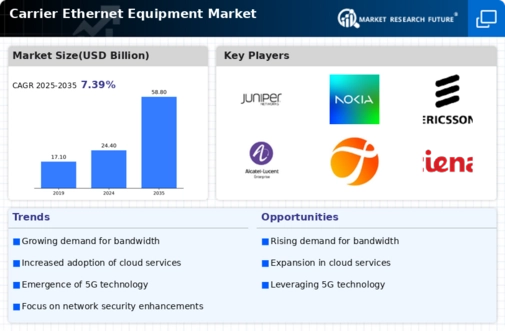Expansion of 5G Networks
The ongoing expansion of 5G networks plays a crucial role in shaping the Global Carrier Ethernet Equipment Market Industry. As telecommunications providers roll out 5G infrastructure, the demand for Carrier Ethernet equipment is expected to rise. 5G technology requires high-capacity and low-latency connections, which Carrier Ethernet can effectively provide. This synergy between 5G and Carrier Ethernet is likely to lead to increased investments, as the market is projected to reach 58.8 USD Billion by 2035. The integration of these technologies may enhance user experiences and facilitate the development of innovative applications, further driving the growth of the Carrier Ethernet market.
Market Growth Projections
The Global Carrier Ethernet Equipment Market Industry is poised for substantial growth, with projections indicating a market value of 24.4 USD Billion in 2024 and an anticipated increase to 58.8 USD Billion by 2035. This growth trajectory suggests a robust demand for Carrier Ethernet solutions driven by various factors, including the expansion of 5G networks, the rise of IoT devices, and the increasing need for secure and reliable connectivity. The compound annual growth rate (CAGR) of 8.34% from 2025 to 2035 further underscores the market's potential, reflecting the ongoing investments in Ethernet infrastructure and the evolving technological landscape.
Rising Need for Network Security
The Global Carrier Ethernet Equipment Market Industry is also driven by the rising need for enhanced network security. As cyber threats become more sophisticated, organizations are prioritizing secure communication channels. Carrier Ethernet solutions offer advanced security features, such as encryption and traffic management, which are essential for protecting sensitive data. This growing emphasis on security is likely to propel investments in Carrier Ethernet infrastructure, as businesses seek to safeguard their operations against potential breaches. The increasing awareness of cybersecurity risks may lead to a more robust adoption of Carrier Ethernet technologies, ensuring that organizations can maintain secure and reliable network environments.
Increased Adoption of IoT Devices
The proliferation of Internet of Things (IoT) devices significantly influences the Global Carrier Ethernet Equipment Market Industry. As more devices become interconnected, the demand for reliable and scalable Ethernet solutions escalates. Carrier Ethernet provides the necessary bandwidth and performance to support the growing number of IoT applications across various sectors, including healthcare, manufacturing, and smart cities. This trend is expected to contribute to a compound annual growth rate (CAGR) of 8.34% from 2025 to 2035, reflecting the increasing reliance on Ethernet infrastructure to manage and transmit data generated by IoT devices. The integration of Carrier Ethernet with IoT ecosystems may enhance operational efficiency and data management.
Growing Demand for High-Speed Connectivity
The Global Carrier Ethernet Equipment Market Industry experiences a surge in demand for high-speed connectivity solutions. As businesses increasingly rely on cloud-based applications and services, the need for robust and reliable Ethernet networks becomes paramount. This demand is reflected in the projected market value of 24.4 USD Billion in 2024, indicating a significant investment in Ethernet infrastructure. Companies are seeking to enhance their network capabilities to support data-intensive applications, which drives the adoption of Carrier Ethernet solutions. This trend is likely to continue, as organizations prioritize seamless connectivity to maintain competitive advantages in a rapidly evolving digital landscape.
Support for Virtualization and Cloud Services
The support for virtualization and cloud services is a significant driver of the Global Carrier Ethernet Equipment Market Industry. As organizations transition to cloud-based solutions, the demand for flexible and scalable Ethernet networks intensifies. Carrier Ethernet provides the necessary bandwidth and reliability to support virtualized environments and cloud applications. This trend is expected to contribute to the market's growth, as businesses seek to optimize their IT infrastructure for enhanced performance. The ability of Carrier Ethernet to seamlessly integrate with cloud services positions it as a preferred choice for organizations looking to leverage the benefits of virtualization, thereby driving further adoption of Ethernet solutions.



















